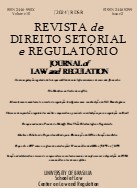Proportionality and Threshold Tests for RIA
the Brazilian situation
Keywords:
AIR, limites e critérios de proporcionalidade, regulação, capacidades institucionaisAbstract
[Purpose] The article addresses the issue of limits and proportionality criteria for carrying out Regulatory Impact Análysis, a practice widely used in developed countries. It seeks to identify how to adapt elements of international experience (models) to restrictions or deficiencies in installed capacity in Brazil, as well as the perception of regulators regarding the topic.
[Methodology/approach/design] This is qualitative research made use of bibliographical research, documentary research and interviews.
[Findings] It was found that, despite its potential to generate great benefits for the country's regulatory and competitive environment, as pointed out in the literature, evidence from interviews with regulators demonstrated that there was no consensus on the need for its adoption in the country. It is also observed that there is a great diversity of models adopted which, in general, result from the characteristics of the country and its institutional capabilities.
[Practical implications] Therefore, in addition to the need to seek to disseminate the advantages of adopting a model for the country, further discussion is needed on the characteristics of the model to be adopted, as well as related topics, such as regulatory costs of the country's different economic sectors and data governance, both topics that seem to be neglected in the country.
[Originality/value] By elucidating important characteristics of the Brazilian reality related to regulation in the country, the article fills an important gap. It still stands out for its practical nature, whose findings, once resolved or minimized, have great potential to boost the country's economy.
Downloads
References
ADELLE, C.; WEILAND, S.; DICK, J. Regulatory Impact Assessment: A Survey of Selected Developing and Emerging Economies. v. 36, n. 2, p. 89–96, fev. 2016.
AQUILA, G.; PAMPLONA, E. DE O.; FERREIRA FILHO, J. A. Quantitative regulatory impact analysis: Experience of regulatory agencies in Brazil. v. 59, p. 100931, 1 ago. 2019.
ASPE, (THE ASSISTANCE SECRETARY FOR PLANNING AND EVALUATION). Guidelines For Regulatory Impact Analysis. Washington. D.C.: [s.n.]. Disponível em: <https://aspe.hhs.gov/reports/guidelines-regulatory-impact-analysis>. Acesso em: 20 abr. 2024.
AUSTRALIAN GOVERNMENT, D. O. T. P. M. A. C. Government Guide to Regulatory Impact Analysis. , 2020. Disponível em: <https://oia.pmc.gov.au/sites/default/files/2021-06/australian-government-guide-to-regulatory-impact-analysis.pdf>. Acesso em: 20 abr. 2024
BRASIL. no 10.411. Decreto. 30 jun. 2020, Sec. 1, p. 35.
CAPUTO, É. Avaliação Qualitativa da Aplicação de Análise de Impacto Regulatório pelas Agências Reguladoras: da Recomendação da Casa Civil à Lei no 13848/2019. 2019.
HAHN, R. W. Risks, Costs and Lives Saved: Getting Better Result from Regulation. 1. ed. United State of America, U.S.A.: Hodder Education Publishers, 1996.
HAHN, R. W. Policy Watch Government Analysis of the Benefits and Costs of Regulation. v. 12, n. 4, p. 201–210, 1998.
HAHN, R. W.; TETLOCK, P. C. Has economic analysis improved regulatory decisions? v. 22, n. 1, p. 67–84, 2008.
HAZILLA, M.; KOPP, R. Social Cost of Environmental Quality Regulations: A General Equilibrium Analysis. Social Cost of Environmental Quality Regulations: A General Equilibrium Analysis, v. 98, n. 4, p. 853–73, 1990.
JAFFE, A. B. et al. Environmental regulation and the competitiveness of US manufacturing: what does the evidence tell us. v. 33, n. 1, p. 132–163, mar. 1995.
MORRALL, J. F. A Review of the Record. v. 10, p. 25–34, 1986.
OECD. OECD Regulatory Policy Working Papers. OECD Publishing, , 21 jan. 2019. Disponível em: <https://www.oecd-ilibrary.org/governance/one-in-x-out-regulatory-offsetting-in-selected-oecd-countries_67d71764-en>. Acesso em: 20 abr. 2024
OECD. A closer look at proportionality and threshold tests for RIA: Annex to the OECD Best Practice Principles on Regulatory Impact Assessment. OECD Publishing, 2020. Disponível em: <https://www.oecd.org/regreform/Proportionality-and-threshhold-tests-RIA.pdf>. Acesso em: 20 abr. 2024
OMB, O. OF M. AND B. Executive Order 13563. jan. 2011.
PARKER, R. W. THE EMPIRICAL ROOTS OF THE “REGULATORY REFORM” MOVEMENT: A CRITICAL APPRAISAL. Administrative Law Review, v. 58, n. 2, 2006.
SAAB, F.; SILVA, S. D. A. M. E. Qual a qualidade da análise de impacto regulatório elaborada por agências reguladoras do Brasil? Revista de Administração Pública, v. 56, n. 4, p. 529–549, jul. 2022.
SALINAS, N. A regulamentação da AIR está engessando as escolhas regulatórias? 28 mar. 2023.
TENGS, T. O.; GRAHAM, J. D. The Opportunity Costs of Haphazard Social Investments in Life-Saving. Risks, Costs, And Lives Saved Getting Better Results from Regulation, p. 167–182, jun. 1996.
THE WHITE HOUSE. Information and Regulatory Affairs. . 2023.
TRIGO, S. A. DISSERTAÇÃO APRESENTADA À ESCOLA BRASILEIRA DE ADMINISTRAÇÃO PÚBLICA E DE EMPRESAS PARA OBTENÇÃO DO GRAU DE MESTRE. 2022.
UK GOVERNMENT. Better Regulation Framework: Interim Guidance. n. Crown copyright 2020, mar. 2020.
VISCUSI, W. K.; HAMILTON, J. T. Are Risk Regulators Rational? Evidence from Hazardous Waste Cleanup Decisions. v. 89, n. 4, p. 1010–1027, set. 1999.
Downloads
Published
How to Cite
Issue
Section
License
Copyright (c) 2024 Journal of Law and Regulation

This work is licensed under a Creative Commons Attribution 4.0 International License.
By submitting this paper to the Journal of Law and Regulation, I hereby declare that I agree to the terms of the Creative Commons Attribution 4.0 International (CC BY 4.0), available at http://creativecommons.org/licenses/by/4.0.


